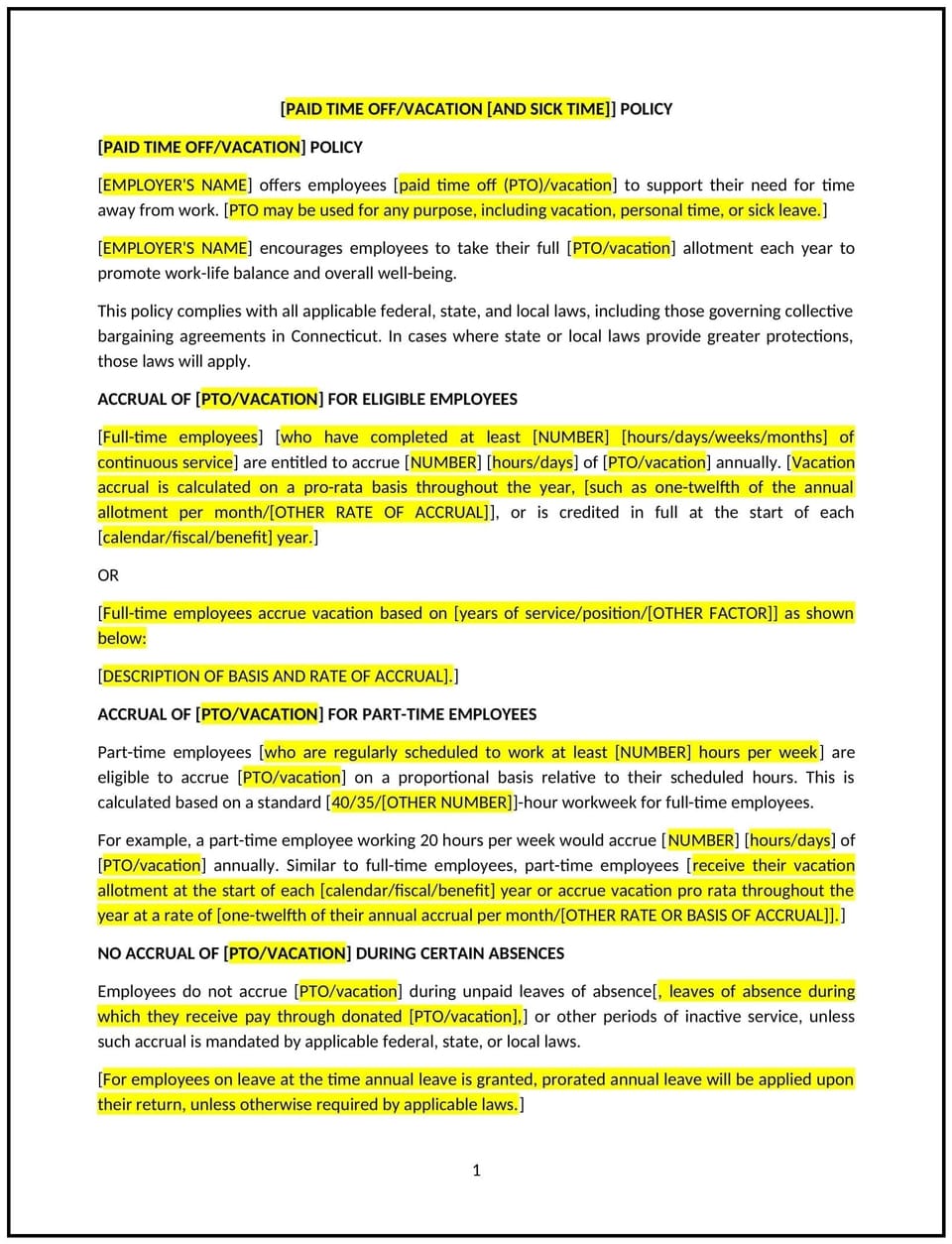Vacation policy (Connecticut): Free template

Vacation policy (Connecticut)
A vacation policy helps Connecticut businesses define how employees can request and use vacation time, setting expectations for time off, accrual, and the approval process. This policy ensures that employees have a clear understanding of their vacation benefits, including how much time off they are entitled to, how vacation time is accrued, and the process for taking vacation.
By implementing this policy, businesses can promote work-life balance, improve employee satisfaction, and ensure that vacation time is used effectively to maintain a productive and healthy workforce.
How to use this vacation policy (Connecticut)
- Define vacation accrual: Specify how vacation time is accrued, such as by hours worked, monthly accrual, or based on length of service. Clarify when employees begin accruing vacation and how much vacation they will receive each year.
- Set eligibility: Outline the criteria for employees to be eligible for vacation, such as the length of employment required to start accruing vacation time.
- Establish a request and approval process: Define the process for employees to request vacation, including how much notice is required, how far in advance requests should be made, and who is responsible for approving time off.
- Address carryover or forfeiture: Specify whether employees can carry over unused vacation days from year to year or whether unused vacation time is forfeited at the end of the year. If carryover is allowed, set limits on how much can be carried over.
- Clarify paid vs. unpaid vacation: Ensure that the policy specifies whether vacation time is paid or unpaid, and the terms for both.
- Provide guidelines for scheduling: Offer flexibility in scheduling vacation time, but also ensure that employees’ absences do not disrupt business operations. Set rules for how vacation time should be scheduled to ensure adequate coverage during peak periods.
- Address holiday overlap: Clarify how vacation time interacts with company holidays. If a holiday falls during an employee’s vacation, specify whether the day will be counted as part of their vacation time or treated separately.
- Define payouts for unused vacation: Specify whether unused vacation time is paid out upon termination or if it expires.
Benefits of using this vacation policy (Connecticut)
This policy offers several benefits for Connecticut businesses:
- Enhances employee satisfaction: By offering a clear and fair vacation policy, businesses can improve employee morale and satisfaction, which contributes to overall productivity and retention.
- Promotes work-life balance: The policy helps employees take the necessary time off to recharge, reducing burnout and improving overall well-being.
- Ensures fairness and consistency: Clear guidelines for vacation accrual, requests, and approval processes ensure all employees are treated fairly and consistently.
- Reduces absenteeism: By managing vacation requests and ensuring employees take their vacation time regularly, the policy helps reduce the risk of burnout and absenteeism.
- Complies with legal requirements: The policy ensures that vacation benefits comply with Connecticut state labor laws, avoiding potential legal disputes over vacation time or benefits.
Tips for using this vacation policy (Connecticut)
- Communicate the policy clearly: Ensure all employees are aware of the vacation policy and understand how to request vacation time, how much time they are entitled to, and any specific rules or limitations.
- Monitor vacation usage: Track vacation accrual and usage to ensure employees take time off regularly and that the company’s vacation liabilities are managed appropriately.
- Encourage planning ahead: Encourage employees to plan vacation in advance, especially during peak periods, to ensure that business operations can continue smoothly and that proper coverage is in place.
- Be flexible: While vacation scheduling should be managed for business continuity, allow employees flexibility to take their vacation when it is most convenient for them.
- Review periodically: Regularly review the policy to ensure it remains competitive, compliant with state laws, and relevant to employee needs.
Q: How does this policy benefit my business?
A: The policy provides clear guidelines for managing vacation time, helping to maintain fairness, consistency, and employee satisfaction. It also ensures that employees take time off to recharge, promoting a healthier, more productive workforce.
Q: How is vacation time accrued?
A: Vacation time can be accrued by hours worked, monthly accruals, or based on length of service. The policy should clarify the accrual method and specify when employees begin accruing vacation time.
Q: How far in advance should vacation requests be made?
A: The policy should specify the required notice period for vacation requests, such as two weeks in advance, to ensure that sufficient coverage is available during the employee’s absence.
Q: Can employees carry over unused vacation time?
A: The policy should specify whether unused vacation time can be carried over to the next year, and if so, any limits on how much can be carried over. If vacation time is forfeited, this should also be clearly stated.
Q: Will employees be paid for unused vacation time when they leave the company?
A: The policy should clarify whether unused vacation time will be paid out when an employee leaves the company, or if it expires. This should align with company practices and legal requirements.
Q: How often should this policy be reviewed?
A: The policy should be reviewed annually or whenever there are changes to Connecticut labor laws, business needs, or company practices to ensure it remains compliant, effective, and aligned with employee expectations.
This article contains general legal information and does not contain legal advice. Cobrief is not a law firm or a substitute for an attorney or law firm. The law is complex and changes often. For legal advice, please ask a lawyer.


